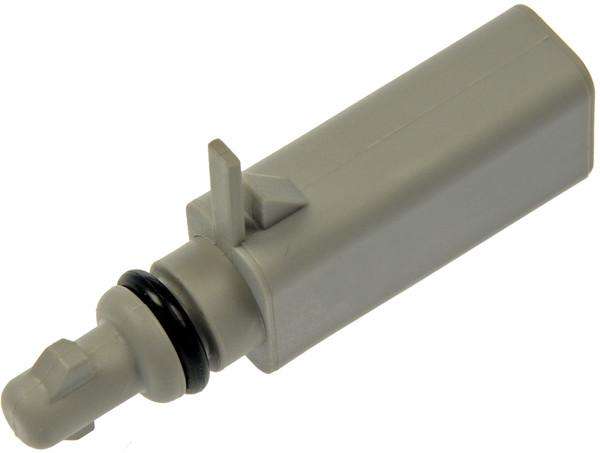
P0698 Sensor Reference Voltage Circuit “C” Low
Content
P0698 – OBD-II Trouble Code Technical Description
Trouble code P0698 indicates that the sensor reference voltage circuit “C” is too low.
What does the fault code mean P0698?
DTC P0698 indicates that the sensor reference voltage circuit “C” is insufficient compared to the manufacturer's specifications. This means that the engine control module (ECM), engine control module (PCM), or one of the vehicle's accessory modules has detected that the voltage supplied to certain sensors is not sufficient for them to operate correctly. The Engine Control Module (ECM) typically has three 5-volt reference circuits. It supplies a 5 volt reference voltage to various sensors. Each circuit provides a 5-volt reference voltage to one or more specific vehicle sensors. Circuit “C” typically provides reference voltage to the A/C refrigerant pressure sensor, fuel filter water sensor, and diesel particulate filter pressure sensor.

Possible reasons
Possible reasons for DTC P0698 may include the following:
- Defective sensors: One possible cause may be due to a defect in one or more sensors that are supposed to supply a 5 volt reference voltage.
- Wiring problems: Opens, shorts, or corrosion in the wires or connections in circuit “C” may result in low voltage.
- Malfunctions in the control module: Problems with the engine control module (ECM) or other auxiliary modules responsible for providing reference voltage to the sensors can also cause trouble code P0698.
- Problems with relays and fuses: Faulty relays or fuses that supply power to the reference voltage can cause voltage problems in the circuit.
- Alternator or battery problems: Malfunctioning alternator or battery problems can cause low voltage in the vehicle's electrical system, including the voltage reference circuit.
These are just some of the possible causes of the P0698 trouble code. To accurately determine the cause, it is necessary to carry out detailed diagnostics using appropriate equipment.
What are the symptoms of a fault code? P0698?
Symptoms associated with DTC P0698 can vary depending on the specific cause and operating conditions of the vehicle, some of the possible symptoms are:
- Check Engine Light: If a problem is detected with the sensor reference voltages, the Check Engine Light may illuminate on the instrument panel. This may be the first sign of a problem.
- Irregular engine operation: Insufficient or unstable reference voltage for the sensors can cause the engine to operate abnormally, such as rough idling, loss of power, or jerky acceleration.
- Systems management problems: Incorrect reference voltage can cause problems with the operation of various vehicle systems, such as the fuel injection system, ignition system, cooling system and others. This may manifest itself in the malfunction of these systems or their complete failure.
- Fault at low speeds: If the voltage is insufficient, problems may occur at low speeds, such as during take-offs or when maneuvering at low speeds.
- Problems with cruise control: Low reference voltage can cause problems with cruise control operation, including malfunction or failure at all.
These symptoms may manifest themselves in different ways depending on the specific operating conditions of the vehicle.
How to diagnose a fault code P0698?
To diagnose DTC P0698, you can follow these steps:
- Scanning trouble codes: First, you need to connect the diagnostic scanner to the vehicle's OBD-II port and check for trouble codes. If a P0698 code is detected, you should write it down and run further diagnostics.
- Checking the voltage in circuit “C”: Using a multimeter, check the voltage on circuit “C” of the sensors reference voltage. The voltage must be stable and meet the manufacturer's specifications.
- Checking sensors and their connections: Check the condition of the sensors for which the reference voltage circuit “C” is intended. Make sure they are connected correctly and there is no sign of damage or corrosion on the connectors.
- Checking wiring and connections: Inspect the wiring and connections in circuit “C” for opens, shorts or damage. Pay attention to areas where wiring passes through areas subject to mechanical or environmental stress.
- Checking relays and fuses: Check the condition of the relays and fuses responsible for the reference voltage circuit “C”. Make sure they are working correctly and there are no signs of overheating or damage.
- Checking the control module: In some cases, the problem may be due to a faulty engine control module (ECM) or other auxiliary modules. Perform additional diagnostics to determine if the module is operating correctly.
- Additional tests: Depending on the vehicle's specific operating conditions, additional tests may be required, such as testing the alternator, battery, and other electrical system components.
If you are unsure of your diagnostic skills, it is recommended that you contact a qualified auto mechanic or service center for further assistance.
Diagnostic errors
When diagnosing DTC P0698, the following errors may occur:
- Ignoring other fault codes: Sometimes problems in one part of the electrical system can cause other parts to read erroneously. When diagnosing, you should consider other trouble codes that may be related to low voltage.
- Lack of attention to wiring: Incorrect reading of the multimeter or insufficient attention to the wiring may lead to incorrect interpretation of the results. It is important to carefully check all wires for breaks, short circuits or damage.
- Sensor malfunction: If you do not pay due attention to checking the condition and connections of sensors, this may lead to erroneous diagnosis. Even if the code indicates a problem with the reference voltage, you need to make sure that the sensors themselves are working correctly.
- Skip Control Module Test: Ignoring possible problems with the engine control module (ECM) or other accessory modules may result in an incomplete diagnosis. You need to make sure that all modules are working correctly.
- Unsatisfactory testing: Incorrect or insufficient testing, especially when checking relays, fuses and other components, can lead to potential causes of a problem being missed.
To avoid these errors, it is important to follow a structured diagnostic procedure, carefully check all components and consider all factors that may affect the operation of the vehicle's electrical system.
How serious is the fault code? P0698?
Trouble code P0698, indicating insufficient voltage on the sensor reference voltage “C” circuit, can be quite serious as it can cause various vehicle systems to malfunction. For example, insufficient voltage can cause erroneous readings of sensors, which will lead to improper operation of the fuel injection system, ignition system, cooling system and others.
In addition, low voltage in the reference circuit can cause problems with various devices such as cruise control or security systems.
Therefore, it is recommended to resolve the problem that caused the P0698 trouble code as soon as possible to avoid further damage and ensure normal vehicle operation. If you notice a check engine light or other symptoms that indicate electrical system problems, it is recommended that you take it to a qualified auto mechanic for diagnosis and repair.
What repair will help eliminate the code? P0698?
To resolve DTC P0698, follow these steps:
- Checking and replacing sensors: Check the condition and correct connections of all sensors for which the reference voltage circuit “C” is intended. If necessary, replace defective sensors.
- Checking and repairing wiring: Inspect the wiring and connectors on circuit “C” for opens, shorts, or damage. If problems are found, make the necessary repairs.
- Checking and replacing relays and fuses: Check the condition of the relays and fuses responsible for the reference voltage circuit “C”. Replace faulty components if necessary.
- Checking and replacing the control module: If the above measures do not solve the problem, the engine control module (ECM) or other auxiliary modules may be faulty. In this case, it is recommended to check, repair or replace the relevant modules.
- Thorough check: After completing all repairs, perform a thorough inspection to ensure that the problem is completely corrected. Perform additional tests and diagnostics as needed to rule out the possibility of further problems.
Remember, to successfully resolve the P0698 code, it is important to have it diagnosed and repaired by a qualified auto mechanic or service center. Incorrect repairs can lead to further problems with the car.
P0698 – Brand-specific information
Trouble code P0698 refers to common error codes and can be found on various brands of cars, several brands of cars with their interpretations of the P0698 code:
- Chevrolet: Error “P0698” – Low voltage in circuit “C” of the sensor reference voltage.
- Ford: Trouble code “P0698” indicates “Oil Pressure Sensor Circuit Low Voltage”.
- Toyota: Trouble code P0698 may be due to “Fuel Pressure Sensor Circuit Low Voltage” or a similar problem.
- Honda (Honda): P0698 could mean “Radiator Fan Control Circuit Low Voltage” or a similar problem.
- Volkswagen: Code P0698 may indicate “Sensor Reference Circuit Low Voltage.”
- BMW: P0698 can be interpreted as “Cooling Fan Motor Control Circuit Low Voltage.”
Please refer to the specific repair and diagnostic documentation for your vehicle brand for more specific information about what the P0698 code means for your specific vehicle.

One comment
Wat
D-mac 2500 year 07, what's the cause of this code?